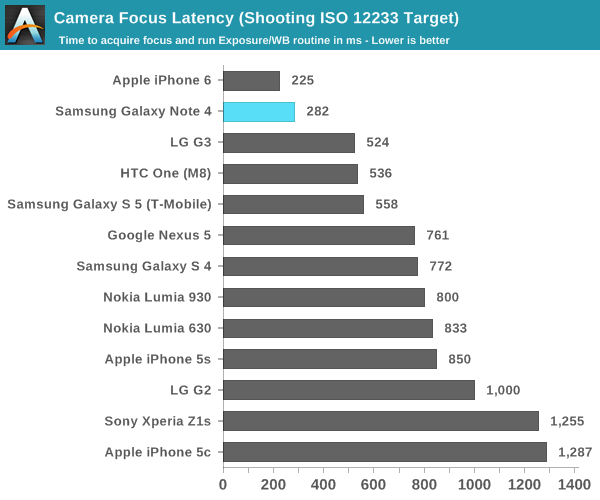The Samsung Galaxy Note 4 Review
by Joshua Ho on October 15, 2014 9:00 AM EST- Posted in
- Smartphones
- Samsung
- Android
- Mobile
- Galaxy Note 4
Camera
While the 16MP camera of the Galaxy Note 4 is mostly what we would expect, Samsung has really changed things up with the addition of OIS. Outside of this addition and the Sony IMX240 sensor, there’s really not a lot of change when it comes to the Galaxy Note 4. This means that we see the same 31mm equivalent focal length and F/2.27 aperture. At this point, it seems that OIS has finally reached mainstream adoption as both Samsung and Apple are shipping OIS solutions on their phones. The front facing camera is noticeably different though, with a Samsung S5K6D1YX sensor that I haven't seen elsewhere.
However, before we get into the proper image quality analysis I wanted to first cover shot to shot latency and focus/AE latency, as both are critical to a good image capture experience. Even if it’s possible to get amazing photos from a camera, it doesn’t really matter if the moment is missed. In order to test this, we look at the ideal case, which is when the phone is pointed at the ISO chart with bright lighting to maximize contrast.


As one can see in the graphs above, capture latency and focus latency are quite competitive with on the Note 4. However, there is one crucial detail that the focus latency graph misses, which is that Samsung doesn’t have continuous auto-focus in preview with the Note 4. As a result, there’s realistically an additional latency period before the auto-focus begins to run. The result is that the total time from out of focus to in focus is realistically closer to 800ms, but if one immediately taps the display to begin an AF run it’s possible to achieve the lower bound value, which is just south of 300ms.
Still Image Performance
While I'm still working on moving towards a better test for cameras, for now we have our standard photo comparisons that should give a good idea of what to expect from a smartphone camera in comparison to other cameras. Our first test is the standard ISO chart, which allows for a good test of maximum resolution.

For this first test, it seems that Samsung hasn't really changed much when it comes to maximum resolution, and in general the Note 4 produces similar output to the Galaxy S5. To verify this and a test of dynamic range, we'll look at a landscape shot next.
In this test, we see that the Galaxy Note 4 generally does well with detail and dynamic range as the landscape is generally well-detailed, although there's quite a bit of detail that seems to be smudged away on the grass as it seems to be a flat green texture for the most part. There's also noticeable color artifacting on the bleachers in the distance. We'll look at the same scene in low light to get a better idea for what the Note 4 really brings to the table.
Here, in low light we see significant improvements in image quality when comparing the Galaxy S5 to the Galaxy Note 4. The iPhone 6 Plus and Note 4 are quite close in overal quality, but looking at the brick building on the right of the image shows that the iPhone 6 Plus is maintaining a higher level of detail in this scene.
In the case of HDR, Samsung continues to do a great job with their implementation. For the most part this feature is successfully implemented with no real halos or other artifacts even when there are moving objects in the shot. This is likely to be implemented through on-sensor HDR rather than image combination.





































195 Comments
View All Comments
KPOM - Wednesday, October 15, 2014 - link
It looks like they focused on the design and the display this time. I like the trend away from over saturated displays.mkozakewich - Wednesday, October 15, 2014 - link
No, they used movie mode. I didn't catch if they went there from where they were.Really, though, a larger gamut is a strength. All we need is for OEMs to create profiles so that we don't have the weird problems we had. They can create an sRGB profile, and an AdobeRGB profile, too. Then, when Android finally supports proper colour systems, they'll be able to introduce that immediately.
Wolfpup - Wednesday, October 15, 2014 - link
Disappointed that this isn't waterproof like the Galaxy S5 and S5 Active. I'd get the S5 just because of that.Samus - Wednesday, October 15, 2014 - link
Waterproof phones have never proven a big hit with consumers. The Kyocera Hydro and Galaxy S5 have a lot of inconvenient plugs and gaskets, with harder to press buttons. Then there is the added weight of the Active. There is always an Achilles heel to mil spec implementation.But it's good consumers have the option of waterproof devices, I just don't think the Note 4 being waterproof would be a compelling feature. I mean, if you drop the thing in the urinal its so big chances are the toilet cake would prop it up...and it's probably not on every sailors list of devices to have something so big.
Hrel - Wednesday, October 15, 2014 - link
There's also the fact that it's not very important to most people, if you'll be by water on a boat or something a $10 bag/case will do. Or hell, even a ziplock bag really. If it's a major concern for you then you're probably willing to spend the $100 on micro-sealing.petar_b - Wednesday, October 15, 2014 - link
I see waterproof feature it more like investment into protecting the investment rather than a feature. I would pay $100 on micro-sealing - just to be sure: if I am walking on the rain (following GPS), or phone accidentally falls in a puddle, or my kid accidentally drops it in the bath that it would survive. And protection bags are ugly, can't go on meeting with that, can't put on/off all the time. Additional frames to protect the screen or side sealing do reduce GPS signal; so no after market solutions.darkich - Wednesday, October 15, 2014 - link
I think the lack of water resistance is actually the result of the stylus slot. I could be wrong, but it seems somewhat logical that waterproofing such design would be difficultTams80 - Thursday, October 16, 2014 - link
I don't think so, unless the plastic of the stylus slot couldn't be impermeable (something to do with thickness?). It uses Wacom Penabled technology, so it should be possible (the Fujitsu Q584 has some water resistance with such a AD stylus).darkich - Wednesday, October 15, 2014 - link
I think the lack of water resistance is actually the result of the stylus slot. I could be wrong, but it seems somewhat logical that waterproofing such design would be difficultrobinthakur - Wednesday, October 15, 2014 - link
Disappointing really, not much wow factor here even if the materials have improved it just looks like a large Galaxy 5 with even less items of interest. Guess I will stay with the iPhone 6 plus.